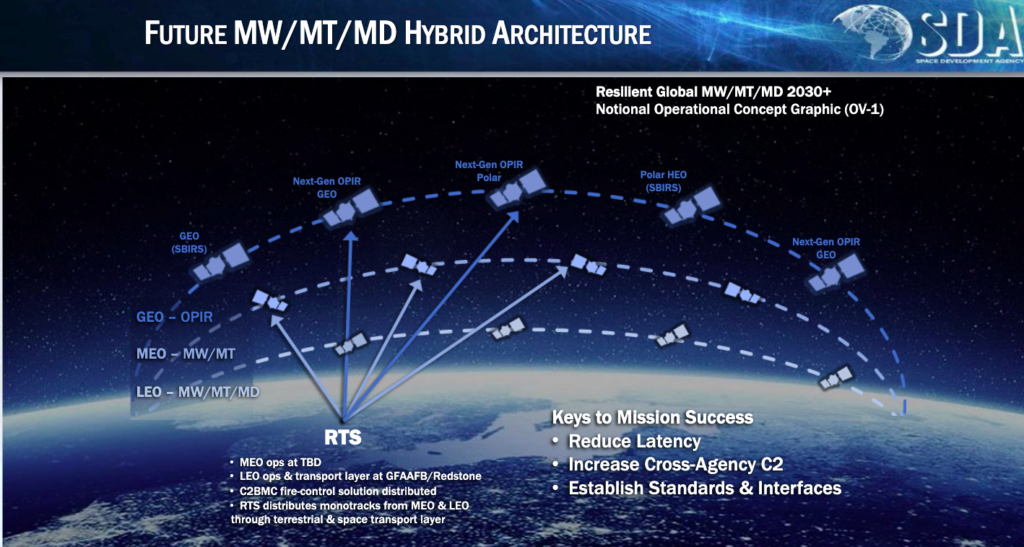
Artist’s illustration of a hypersonic missile tracking satellite constellation. (Graphic by L3Harris)
WASHINGTON: The Space Force’s investment in new space systems designed to provide greater resiliency against adversary attack will begin to show results in 2027, Chief of Space Operations Gen. Jay Raymond told lawmakers today.
In testimony on the service’s fiscal 2023 budget request before the Senate Appropriations defense subcommittee, Raymond explained that the satellites in the current national security satellite system are “very few in numbers, and they’re not very defendable.”
Thus, he elaborated, the Space Force’s top-priority “pivot,” starting in FY23 will turn toward a more resilient on-orbit posture by developing myriad new satellite constellations for various missions to populate most usable Earth orbits — Low Earth Orbit (LEO), Medium Earth Orbit (MEO), Geosynchronous Orbit (GEO) and Highly Elliptical Orbit (HEO) over the poles.
RELATED: 2024 Space Force budget to show ‘large pivot’ to ‘China fight’
“What we’re trying to do is just like you do with your financial portfolios, where you diversify your financial portfolio so you don’t go broke if one stock takes a tumble. We want to do the same thing with our satellite architecture,” Raymond said.

The new missile warning, tracking and defense “hybrid architecture” will include satellites in Low, Medium and Geosynchronous Orbits. (Space Development Agency)
Space Force expects the new architecture to reach initial operating capability by 2027, he said.Missile warning, tracking and defense, including for hypersonic missiles, is the first space mission with a fully articulated resilient “force design” crafted by the Space Warfighting Analysis Center (SWAC). The architecture includes development of new MEO-based satellites to be developed by Space Systems Command, others for the proliferated LEO constellation being developed by the Space Development Agency (SDA) for its Tracking Layer, and the on-going Next-Generation Overhead Persistent Infrared program, which includes three satellites in GEO and two in polar HEO.
The idea, SDA Director Derek Tournear told the Potomac Officers Club today, is that “you gain resilience through proliferation.” SDA, which currently reports to the Pentagon’s research and engineering office, will be transferred to the Space Force by October.
The “hybrid architecture” for missile warning, tracking and defense is envisioned to be fully up and running circa 2030, according to one of the slides he presented. However, Tournear explained that an “initial global capability” for warning and tracking from LEO/MEO will be available in the 2026 time frame based on 28 SDA Tracking Layer satellites and four MEO satellites; and a “robust global capability” when the number of Tracking Layer birds hits 80 in 2027.
Moreover, the Space Force’s unfunded priorities list, obtained by Breaking Defense, asks for an extra $200 million to speed up deployment of that architecture. The funds would buy two launches in FY23 “to accelerate Initial Launch Capability in FY25 for the MW/MT Tracking Layer,” the document shows.
Air Force Secretary Frank Kendall said in today’s hearing that while the department, which provides civilian management for both the Air Force and the Space Force, has “started the transition to resilient systems,” the effort has a ways to go.
“We have a lot more to do, I think, on the on the side of protecting our forces from other people’s assets in space,” he said. “So, there’s more work that needs to be done to define that.”
Space Force EW unit working to integrate new weapon systems, intel personnel
The Space Force’s Delta 3 is responsible for organizing, training and equipping Guardians for electronic warfare missions involving satellite communications, as well as sustaining related offensive and defensive EW systems.


























